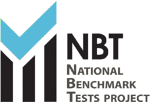Test Content
The Academic Literacy test (one of two components of the Academic & Quantitative Literacy test) assesses capacity to engage successfully with the demands of academic study in the language of instruction.
The Quantitative Literacy test (one of two components of the Academic & Quantitative Literacy test) assesses ability to manage situations or solve problems of a quantitative nature in real contexts relevant to higher education.
The Mathematics test assesses proficiency levels in the skills listed below as they relate to the study of mathematics at the tertiary level.
The NBT assesses a writer’s proficiency levels in three content areas, focusing on the following:
ACADEMIC LITERACY
- Make meaning from text, typical to that encountered in tertiary studies;
- Understand vocabulary related to academic study, in context;
- Identify and track points and claims made in texts;
- Evaluate evidence used to support claims made by writers;
- Extrapolate and draw inferences and conclusions from text;
- Differentiate main from supporting ideas in the overall and specific organisation of a passage;
- Identify text differences that relate to writers’ different purposes, audiences, and kinds of communication;
- Understand and interpret information that is presented visually (e.g. in tables and flow-charts); and
- Understand basic numerical concepts and information used in text.
QUANTITATIVE LITERACY
- Select and use a range of quantitative terms and phrases;
- Apply quantitative procedures in various situations;
- Formulate and apply formulae;
- Read and interpret tables, graphs, charts and text and integrate information from different sources;
- Do calculations involving multiple steps accurately;
- Identify trends and patterns in various situations;
- Apply properties of simple geometric shapes to determine measurements;
- Reason logically; and
- Interpret quantitative information presented verbally, symbolically, and graphically.
MATHEMATICS
- Understand and apply properties of the real number system;
- Recognise and use patterns, including sequences and series;
- Apply relationships such as ratios and percentages in a variety of contexts;
- Use surds, logarithms and exponents in a variety of algebraic and numerical contexts, including solution of exponential equations and financial calculations;
- Carry out algebraic manipulations, apply these in the solution of equations and inequalities;
- Solve problems using mathematical process skills;
- Understand the function concept and identify properties of functions, such as domain and range, in the context of straight lines, parabolas, hyperbolas, exponential and logarithmic graphs, and trigonometric graphs (sine, cosine, tangent);
- Identify relationships between graphs and their equations, or inequalities and the regions they describe;
- Interpret transformations of functions represented algebraically or graphically;
- Apply trigonometric concepts in solving problems;
- Understand and use trigonometric identities in solving equations;
- Understand properties and interpret representations of two-dimensional and three-dimensional shapes;
- Solve problems relating to perimeter, area, volume;
- Apply principles of analytic geometry;
- Interpret various representations and measures of data; and
- Use logical skills in making deductions and determining the validity of given assertions.
